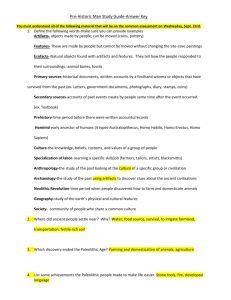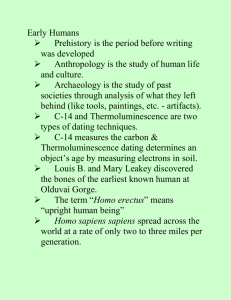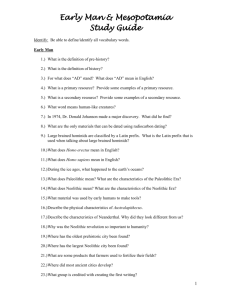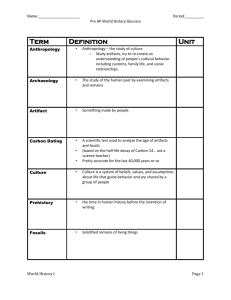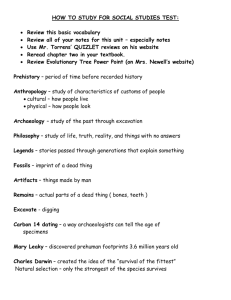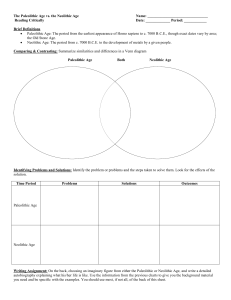bentley5_tb_ch01
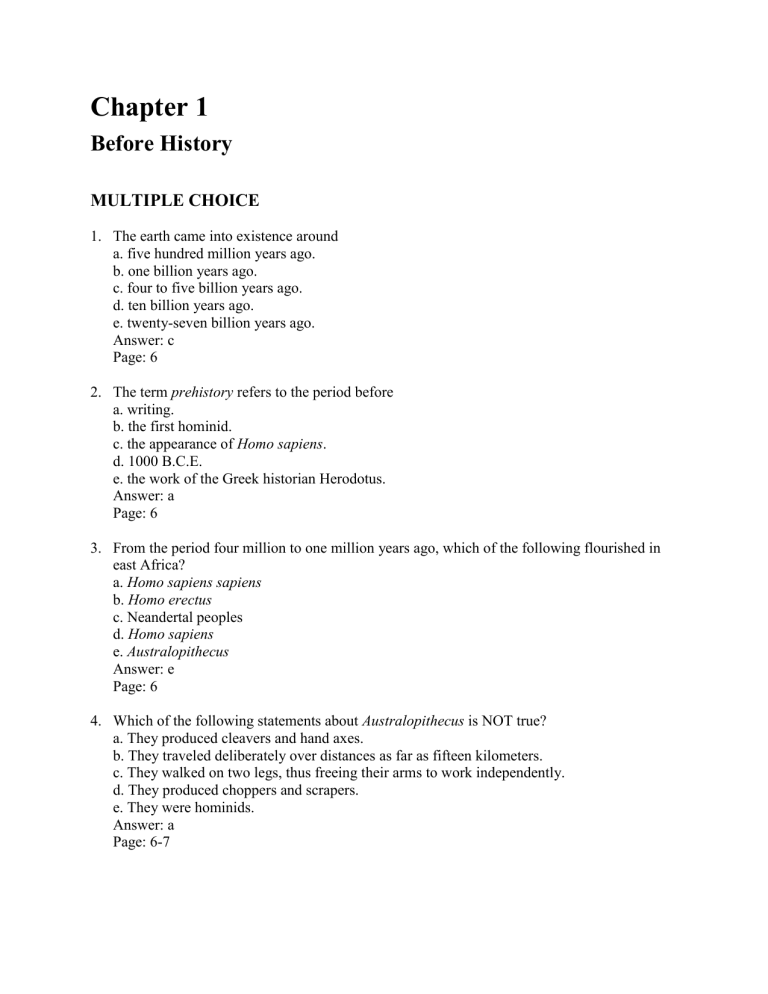
Chapter 1
Before History
MULTIPLE CHOICE
1. The earth came into existence around a. five hundred million years ago. b. one billion years ago. c. four to five billion years ago. d. ten billion years ago. e. twenty-seven billion years ago.
Answer: c
Page: 6
2. The term prehistory refers to the period before a. writing. b. the first hominid. c. the appearance of Homo sapiens . d. 1000 B.C.E. e. the work of the Greek historian Herodotus.
Answer: a
Page: 6
3. From the period four million to one million years ago, which of the following flourished in east Africa? a. Homo sapiens sapiens b. Homo erectus c. Neandertal peoples d. Homo sapiens e. Australopithecus
Answer: e
Page: 6
4. Which of the following statements about Australopithecus is NOT true? a. They produced cleavers and hand axes. b. They traveled deliberately over distances as far as fifteen kilometers. c. They walked on two legs, thus freeing their arms to work independently. d. They produced choppers and scrapers. e. They were hominids.
Answer: a
Page: 6-7
5. The most important development of Homo erectus was a. fire. b. stone tools. c. walking upright on two legs. d. their communication skills. e. writing.
Answer: d
Page: 7
6. Which of the following statements is NOT true of Homo erectus?
a. They knew how to control fire. b. They developed language skills that enabled them to communicate complex ideas. c. They had brains roughly the same size as those of modern humans. d. They produced cleavers and hand axes. e. They walked upright on two legs.
Answer: c
Page: 7
7. Homo sapiens evolved a. one million years ago. b. five hundred thousand years ago. c. one hundred thousand years ago. d. two hundred thousand years ago. e. forty thousand years ago.
Answer: d
Page: 7
8. Homo sapiens had appeared in almost all the habitable regions of the world by around
________ years ago. a. 250,000 b. 100,000 c. 50,000 d. 15,000 e. 5,000
Answer: d
Page: 9
9. Homo sapiens used superior knowledge, sophisticated tools, and language to a. build cities. b. exploit the natural world more efficiently than any other species. c. establish complex social and political institutions. d. make tools and fire. e. communicate limited ideas to each other.
Answer: b
Page: 10
10. Which of the following statements is true of the inhabitants of the paleolithic age? a. They had mastered writing. b. They domesticated animals. c. They were hunters and gatherers. d. They had discovered agriculture. e. They had mastered working with iron.
Answer: c
Page: 10
11. Most scholars believe that, during the paleolithic age, social organization was characterized by a. a relative social equality. b. a ruling priestly class. c. a dominant class based on the private ownership of land. d. a ruling merchant class. e. a dominant matriarchal structure.
Answer: a
Page: 10
12. Many scholars believe that during the paleolithic age the relationship between the sexes was marked by a. a female-dominated society based on the importance of gathering edible plants. b. general social equality. c. a male-dominated society based on the preeminence of hunting. d. a male-dominated society based on sheer physical strength. e. a male-dominated society based on the central role of the male sun god.
Answer: b
Page: 10
13. The Venus figurines a. were first found in the ruins of Çatal Hüyük. b. date back to the time of Australopithecus . c. were representative of the matriarchal societies of the neolithic age. d. are representations of the goddess of love found in Jericho. e. reflect early humans’ deep interest in fertility.
Answer: e
Page: 14
14. With the development of languages, human beings were able to a. produce long cutting edges. b. accumulate knowledge and transmit it to new generations. c. begin to fashion sharp tools from animal bones. d. devise means for catching fish from deep waters. e. invent spear throwers.
Answer: b
Page: 14
15. One of the interpretations of the early human cave paintings is that they represent a. positive proof of the limited intellectual world of the early human. b. early worship of the forces of evil. c. a variety of sympathetic magic. d. the first conscious development of art for its own sake. e. a complicated, and so far indecipherable, written language.
Answer: c
Page: 15
16. What do archeologists now believe is the most fundamental difference between the neolithic and paleolithic eras? a. artistry b. use of tools c. use of fire d. reliance on foraging for subsistence e. reliance on cultivation for subsistence
Answer: e
Page: 15
17. One of the earliest known agricultural techniques was a. crop rotation. b. hunting and gathering. c. slash and burn. d. crop substitution. e. the use of the horse-drawn plow.
Answer: c
Page: 17
18. The mastery of agriculture led to a population explosion. From a sparse population of around four million in 10,000 B.C.E., the global figure rose by 500 B.C.E.
to around a. ten million. b. forty million. c. one hundred million. d. two hundred million. e. three hundred million.
Answer: c
Page: 17
19. One of the earliest neolithic settlements was ________, which was located at a freshwater oasis north of the Dead Sea and had a population of around two thousand. a. Jericho b. Çatal Hüyük c. Altamira d. Lascaux e. Jomon
Answer: a
Page: 17
20. Çatal Hüyük is significant because a. it marks the beginning of human civilization. b. it marks the first human use of tools. c. it was the site of the first human agriculture. d. it is one of the best known neolithic settlements. e. it was the first instance of the use of a land bridge.
Answer: d
Page: 18
21. The earliest of the three neolithic craft industries was a. textile production. b. pottery. c. carpet weaving. d. metallurgy. e. weapon production.
Answer: b
Page: 18
22. The earliest metal worked systematically by humans was a. copper. b. tin. c. bronze. d. iron. e. steel.
Answer: a
Page: 19
23. The ultimate source of wealth in any agricultural society is a. gold. b. copper. c. land. d. control over the protective deities. e. the accumulation of weapons.
Answer: c
Page: 20
24. Because of the changing nature of agriculture, neolithic worshippers sometimes associated fertility with animals like a. bulls. b. birds. c. bears. d. frogs or butterflies. e. rats.
Answer: d
Page: 20
25. Cities differed from neolithic villages in two principal ways. First, cities were larger and more complex than neolithic villages. The second difference was that a. cities served the needs of their inhabitants and immediate neighbors. b. cities decisively influenced the economic, political, and cultural life of large regions. c. cities were less advanced militarily. d. cities had populations in the thousands. e. cities had protective deities.
Answer: b
Page: 21
TRUE/FALSE
26. Homo erectus flourished from around two million to two hundred thousand years ago.
Answer: True
Page: 7
27. Jericho is a site of cave paintings in Spain.
Answer: False
Page: 17
28. Çatal Hüyük was a village in south central Anatolia with a population of around five thousand.
Answer: True
Page: 18
29. The definition of Homo sapiens is “consciously thinking human.”
Answer: True
Page: 7
30. The Neandertal were people who flourished in Europe from around two-hundred thousand to thirty-five thousand years ago and who performed deliberate burials accompanied by ritual observances.
Answer: True
Page: 13
31. The term for “new stone age” is neolithic.
Answer: True
Page: 15
32. The sculptures of women usually depicted with exaggerated sexual features are known as
Venus figurines.
Answer: True
Page: 14
33. Homo erectus is the order of primates that flourished in Africa as early as four million years ago.
Answer: False
Page: 7
ESSAY
34. Trace the development of Australopithecus , Homo erectus , and Homo sapiens . What effect did they have on the world around them?
35. Explore the rise of the city. In what ways was the city different from the large villages of the earlier neolithic age?
36. Richard Leakey wrote, “Humans are unique because they have the capacity to choose what they do.” What is the significance of this statement? When did humans develop the ability to choose? Is there a negative side to this capability?
37. Are there drawbacks to the rise of complex societies? In other words, is every aspect of civilization good? Are there still problems today that stretch back to the rise of civilization?
38. Examine the profound changes brought about by the discovery of agriculture. How did this seemingly simple discovery change the course of human history?
39. Explore the culture of the paleolithic age. What does it say about their changing world? In what ways did paleolithic humans try to make sense of the world?
40. Examine the changing world of the neolithic age. What were the foundations of this age? In what fundamental ways was it different from the preceding paleolithic age? In what ways were the accomplishments of this period setting the stage for the rise of complex societies?
41. Discuss some of the profound differences between the paleolithic and neolithic ages. What allowed for these differences? How did these differences affect development after the neolithic age?
42. Explore the early human cave paintings at Lascaux and Altamira. Explain how this art is an expression of human advancement.
43. What do the elaborate burial rituals of Neandertal humans tell us about these people and their view of their place in the universe?
44. Use the maps in this chapter to follow the path of human habitation. What areas were inhabited most recently? Why?
45. Examine Map 1.2, Origins and early spread of agriculture. What can the type and spread of agricultural products tell us about the movements of human beings and the nature of their relationship to each other?
46. Examine the image of the Venus figurine on page 14. What is the significance of this image?
What can it tell us about the mind-set of early humans? Why would this image represent fertility to early humans?
47. What could the cave painting on page 13 tell the modern viewer about the paleolithic world?
How does it express the paleolithic belief of sympathetic magic?
48. Look at the cave paintings on pages 15 and 16. How do they represent the changing world of the neolithic age? Why would the themes be different from those in paleolithic cave paintings?
49. Look at the picture of the pottery on page 20. What role did pottery play in human development? Why would it be in the shape of a deer?
50. What was the significance of the discovery of Lucy’s bones?
51. What set the genus Australopithecus apart from other animal species of the time?
52. What were the most important changes in the evolution from Australopithecus to Homo erectus ?
53. What advantages did Homo sapiens possess over Homo erectus ?
54. What were the differences between the Neandertal and Homo sapiens ?
55. What is the significance of cave art? The Venus figurines?
56. How did the gradual transformation from hunting and gathering to agriculture probably occur? How did it spread?
57. What were the most significant positive and negative effects of the agricultural transition on human society?
58. What were the earliest craft industries to emerge and how did they benefit those living in neolithic villages?
59. How did early cities differ from neolithic villages and towns?

